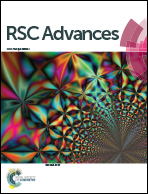An antifouling electrochemical immunosensor for carcinoembryonic antigen based on hyaluronic acid doped conducting polymer PEDOT†
Abstract
Nonspecific binding is a critical issue in protein immunoassays, and the construction of sensing interfaces that can dramatically resist nonspecific protein adsorption in complex biological media is of great significance. Herein, an antifouling electrochemical immunosensor for a tumor biomarker, carcinoembryonic antigen (CEA) was developed based on a novel conducting polymer composite, poly(3,4-ethylenedioxythiophene) (PEDOT) doped with hyaluronic acid (HA). The electrodeposited PEDOT/HA composite had a porous microstructure and strong hydrophilicity, and it also possessed many carboxylic groups on its surface that can be used for the immobilization of the capture probe CEA antibodies. The CEA immunosensor based on PEDOT/HA exhibited high sensitivity to CEA over a wide linear range of concentrations from 1 pg mL−1 to 0.1 μg mL−1, with a detection limit of 0.3 pg mL−1. Moreover, the developed immunosensor is highly specific and antifouling, and it can be used for the assay of CEA in real human serum samples without suffering from strong nonspecific protein adsorption.


 Please wait while we load your content...
Please wait while we load your content...